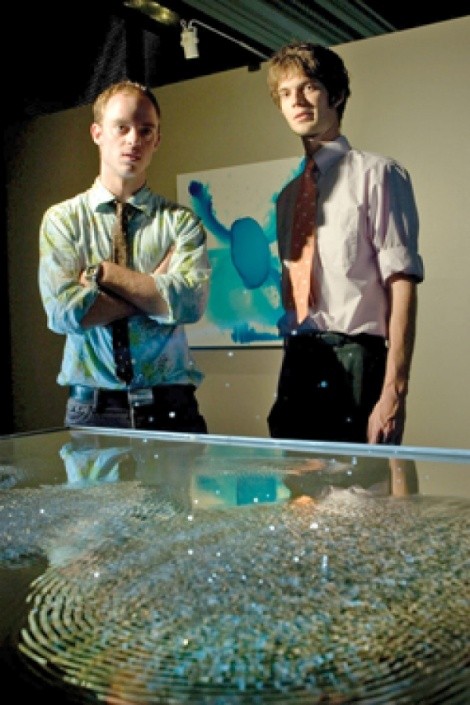
This project began in 2005 when Metcalf and Nebeker, art students at BYU, took a watercolor class together and decided to embark on a collaborative project. Metcalf had attempted sound art before, but he says he wanted something “more alternative.” They tried stretching specially treated paper over acoustic speakers and allowing different sound vibrations to move ink around the surface.
Then they got really serious, when they asked professors Timothy Leishman and Hales Swift in the BYU physics department for their assistance on acoustics. The exhibit at the Rio uses waveform generators in another room to project sound vibrations in a spectrum from 35 to 150 Hz, connected to two water tables to demonstrate to viewers the interaction of sound, energy and matter to create a work constantly in motion. Monocolor ink-on-paper prints on the wall provide evidence of the end results of their visual vibratory exercises derived from ambient noise gathered from Salt Lake City: splotches and squiggles that are often stunning.
Wayne Madsen, Brian Christensen and Joseph Ostraff served as artistic collaborators who helped with formal, technical and documentary aspects of the work. Their participation included the development of a brief video loop showing the creation of one of their visual works. Coming at the natural end of a journey through the exhibit, the video ties everything together and makes their process seem much more organic than it might otherwise.
Metcalf is already conversant with the live and immediate aspect of this work through his performance art, which has been presented at the SCOPE International Contemporary Art Fair in Miami and New York. The connection between the visual and performance elements comes from the conceptual qualities of the work. Musician and art critic David Toop noted in Tate Etc. that “sound art and art and sound all grow from a vast range of issues, so we have to ask if a better understanding can be reached between all the factions.” The process and end result of this kind of work can, at its best, compel us to re-examine how art is created—and this show succeeds in that goal.
Metcalf and Nebeker believe there is an untouched niche of sound art which “marries the aesthetic and conceptual, the given and the implied.” This show moves beyond something that might come off as a mere artistic science experiment through the emotive character of some of the ink pieces on display, like exploding suns or intricate patterns of droplets like some microscopic geography.
The spectrum of light interacts with the spectrum of sound—the colors used in each piece correlate to the higher or lower frequency used to create them—to suggest interrelations between the two that spectators could follow into philosophical discourse. Metcalf doesn’t read a deeper meaning into the works, however, but is elated at being able to “see a sound. I just enjoy the process of making them.”
Nebeker finds different rewards in the work: “I really like the dynamics in the way the show evolved, as we built the water table and developed applications.” He adds, “I imagine myself as a viewer experiencing the way the shapes evolve in different ways. Some people say they look like Jackson Pollock’s but then as they study them see much more subtlety and movement.”
AUDIOPTIC SALT LAKE Rio Gallery, 300 S. 455 West. Through Sept. 7. 533-3582
cw